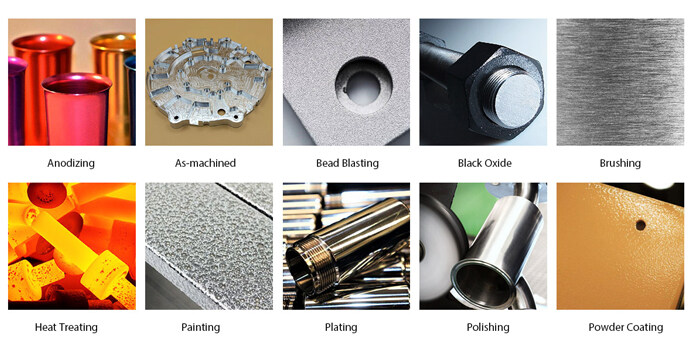Surface Treatment

Our finishing aims to alter the surface of a prototype part in order to achieve a particular characteristic.
Precision finishing services enable metal parts or components to have increased durability, tighter tolerances, improved functionality, and enhanced aesthetics.
Our precision outsourced finishing services provide a convenient and cost-effective way to achieve the protection and look your project requires. Our proven and reliable outsourcing partners can save you time and money while alleviating the stress of offering these services in-house.
These finishes include but are not limited to the following:
Anodizing
Anodizing is an electrical processes that infuses the color into the material and creates beautiful shades of color. Anodized metal parts effectively increase corrosion resistance, and also enhancing visual qualities and keeping the surface from being scratched.
Applicable materials: aluminium alloys.
Colors: clear, black, grey, red, blue, gold.
As Machined
As machined parts—or parts that come right off the machine—have minor visible tool marks and a standard surface roughness (Ra) is 3.2 μm. Surface finish requirements can be increased to 1.6, 0.8 and 0.4 μm.
Bead Blasting
Bead blasted parts have a matte finish with a light texture. It’s mainly used to improve a part’s visual appearance.
Zinc Plating
Zinc plating, which is also known as galvanization, is applied to prevent the surface from oxidizing or corroding.
Applicable materials: steel and stainless steel.
Nickel Plating
Nickel plating is the process of electrolytically depositing a layer of nickel onto a substrate. Parts processed with nickel plating layer have an excellent degree of corrosion resistance and can maintain their surface appearance and brightness over time.
Applicable materials: steel and stainless steel.
Gold Plating
Gold Plating provides good corrosion and tarnish resistance with excellent solderability.
Applicable materials: aluminum, stainless steel, steel.
Silver Plating
Silver offers high solderability and electrical conductivity but is susceptible to tarnish.
Applicable materials: aluminum, stainless steel, steel.
Polishing
Parts are manually polished in multiple directions. Surface is smooth and slightly reflective.
Powder Coating
Powder coating adds a wear- and corrosion-resistant finish to the surface of the parts. It has higher impact resistance compared to anodizing, comes with a large range of colors, and can be applied to any metal.
Electropolishing
Electropolishing creates a clean surface, best for parts that need to be smooth at a microscopic level.
Applicable materials: nearly any metal. The most common are aluminum, copper, stainless steel, titanium, and nickel and copper alloys.
Smooth Machining
Smooth machining is best for precise parts where the surface roughness needs to be fine, but is not suitable for customer-facing products.
Applicable materials: nearly any metal.
Passivation
Passivation is a widely-used metal finishing process to prevent corrosion.
Applicable materials: stainless steel, alloy steels.